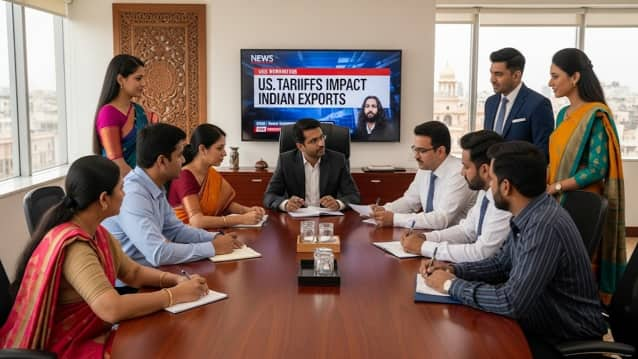Lenders are shaving expenses, pushing factoring, and spreading awareness, but they acknowledge that these efforts alone will not be enough.

Unless the government steps in with targeted support, such as interest subvention, exporters may have little choice but to diversify markets or sharpen operational efficiencies to withstand the tariff blow. (Source: AI Image)
The tariff shock from the US is eating into the margins of India’s small exporters, but financiers say their hands are somewhat tied to enhance support measures. Despite trimming onboarding fees, cutting charges, and offering factoring solutions, non-banking finance companies (NBFCs) and fintech lenders argue that high borrowing costs, RBI regulations, and margin pressure leave them with little room to manoeuvre.
Unless the government steps in with targeted support, such as interest subvention, exporters may have little choice but to diversify markets or sharpen operational efficiencies to withstand the tariff blow. The 25 per cent tariff imposed by the US, which will take effect from August 27, is in addition to the existing 25 per cent.
Exporters often turn to NBFCs for faster, more flexible credit than banks, but these institutions operate within strict guardrails. RBI rules on asset classification and provisioning restrict lenders from overextending credit, even if demand exists. “If an exporter goes delinquent, it hurts both the MSME and the NBFC,” Pramit Joshi, Vice President, Credlix, a supply chain finance lender and factoring company tells FE BFSI. That, he noted, leaves little scope for lenders to take on additional risk in the current environment.
The bigger hurdle than that is cost. NBFCs borrow at higher rates than banks, which means their end-loans are inevitably priced steeper. While some have trimmed processing and onboarding fees to ease costs for exporters, the impact is negligible. “On a Rs 1 crore loan, reducing fees from 1 per cent to 0.25 per cent hardly changes the financing burden,” Joshi says, underscoring that without policy support, the cost of credit cannot be meaningfully reduced.
Also read: RBI’s Co-Lending Shake-Up: What Changes for Lenders from 2026
Financiers across the spectrum admit margins are stretched. Supply chain finance company KredX CEO Manish Kumar says lenders are dealing with higher compliance costs, provisioning requirements for non-performing assets (NPAs), and shrinking low-cost bank deposits that raise the cost of capital. “There is only so much we can do—lenders cannot operate at unit-level losses,” he said.
Even after trimming costs by 15–20 per cent, the headroom to pass benefits on to exporters remains thin. According to Amitabh Chaturvedi, Founder & Executive Chairman at NBFC Purple Finance, while public sector banks may have some flexibility to extend selective support, NBFCs are unlikely to offer broad-based relief. In his view, exporters will ultimately need to adjust by diversifying markets or improving efficiency rather than expecting sustained financing concessions.
The timing of the tariffs has hit hardest in labour-intensive sectors like garments, textiles, gems and jewellery, and chemicals, where India faces stiff competition from Southeast Asian economies. Any increase in landed cost immediately weakens India’s edge. Kumar pointed out that if garments become 50 per cent costlier, even if US buyers absorb part of the increase, there remains a sizeable delta that exporters themselves must shoulder.
For smaller exporters already squeezed by input cost inflation and currency volatility, this compounds the challenge. KredX alone works with nearly 15,000 MSMEs, a large number of them dependent on the US market, illustrating the scale of exposure.
Industry voices are unanimous that structural relief can only come from policy. Raman Aggarwal, CEO of NBFC body FIDC, noted that during Covid the RBI allowed a one-time restructuring of loans, which gave temporary breathing space and something similar may be needed now.
Also read: Paytm’s Reset Moment: What the Payment Aggregator Licence Really Means
“Support is something which has to come from the regulator. I think government is already working on something to support. If there is additional support to be given in terms of any interest subsidy etc., it has to be driven by policies and regulation,” said Aggarwal.
Interest subvention, where the government absorbs part of the borrowing cost, is being widely discussed as a potential tool. Exporters argue that such a measure could be a lifeline, particularly as American buyers are reportedly asking Indian suppliers to take on as much as half the tariff cost. Without relief, working capital cycles will tighten further, raising the risk of defaults.
In the absence of sweeping policy action, NBFCs are pushing factoring as a stopgap liquidity tool. By purchasing exporters’ receivables, lenders provide upfront cash without collateral, often clearing the balance sheet within weeks. “In the current context, I would say that one should look at factoring as a tool for financing. Ultimately, we need to ensure that capital flows to the MSME and factoring is a very potent tool in the current scenario,” Joshi explains.
While factoring volumes in India remain modest compared to developed markets, NBFCs believe its adoption could rise as exporters search for alternative ways to smoothen cash cycles.
Lenders are also trying to provide targeted relief where possible. KredX has reduced onboarding and transaction fees by up to 30 per cent for stressed sectors and is running roadshows with MSME ministry-backed District Industries Centres to raise awareness of financing options. Credlix, meanwhile, is helping exporters identify new geographies to reduce overdependence on the US market.
Also read: Stress, Caution and Shrinking Portfolios: Why Microfinance Isn’t Out of the Woods Yet
These measures, however, are incremental rather than transformative. As Joshi put it, such steps may ease pressure at the margins but will not offset the scale of the tariff impact.
For now, exporters are caught between rising costs and limited financing flexibility. Lenders are shaving expenses, pushing factoring, and spreading awareness, but they acknowledge that these efforts alone will not be enough. Sustained government support through interest subvention, targeted restructuring, or new credit guarantees along with exporter adaptability in terms of market diversification and efficiency gains will likely decide how India’s small exporters weather the storm.
Empower your business. Get practical tips, market insights, and growth strategies delivered to your inbox
By continuing you agree to our Privacy Policy & Terms & Conditions
